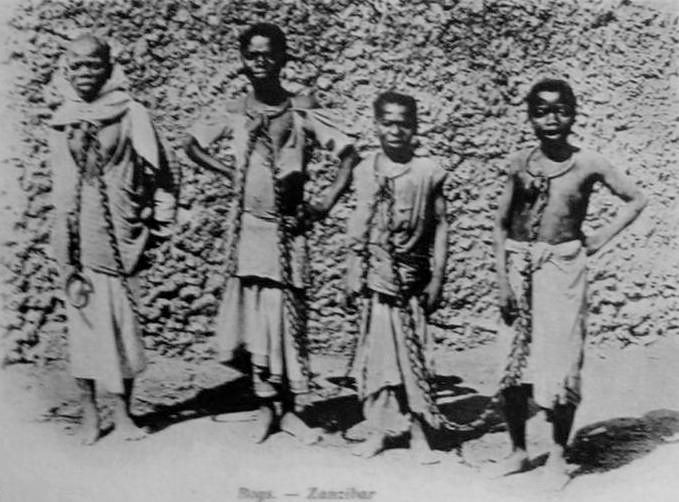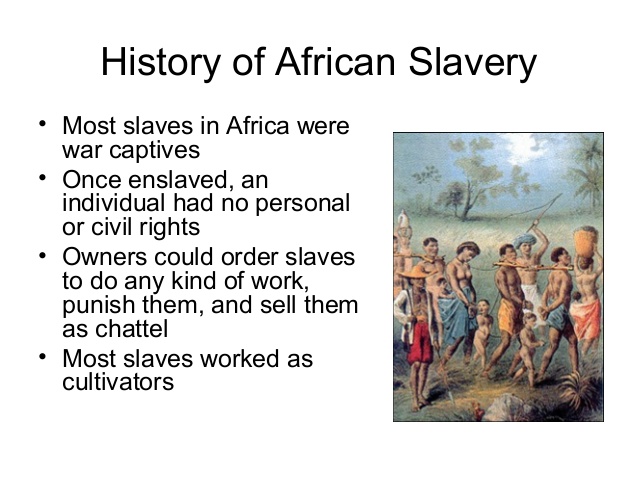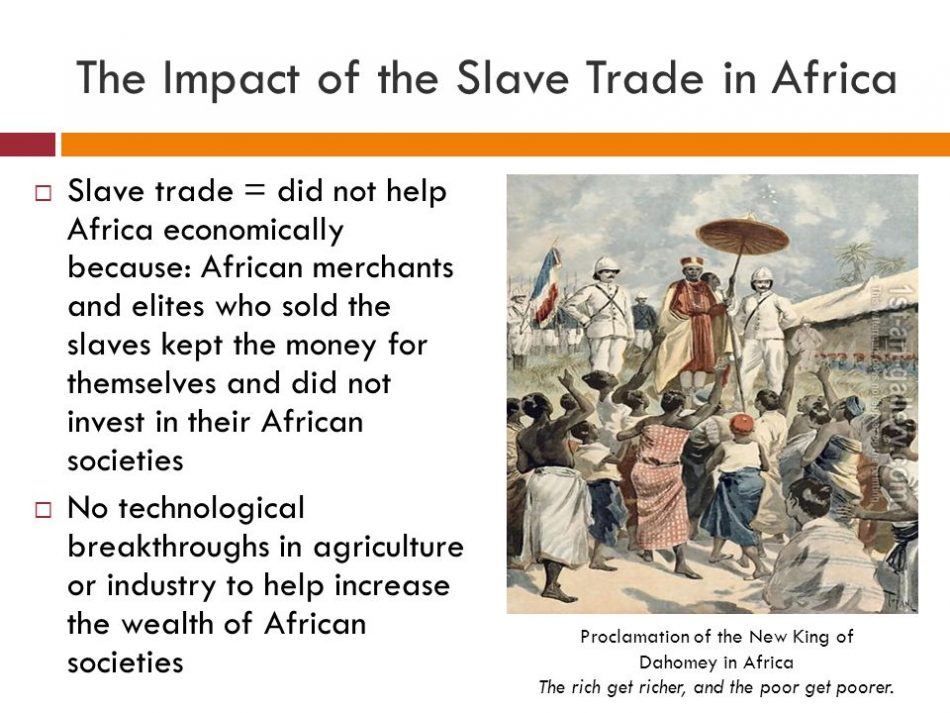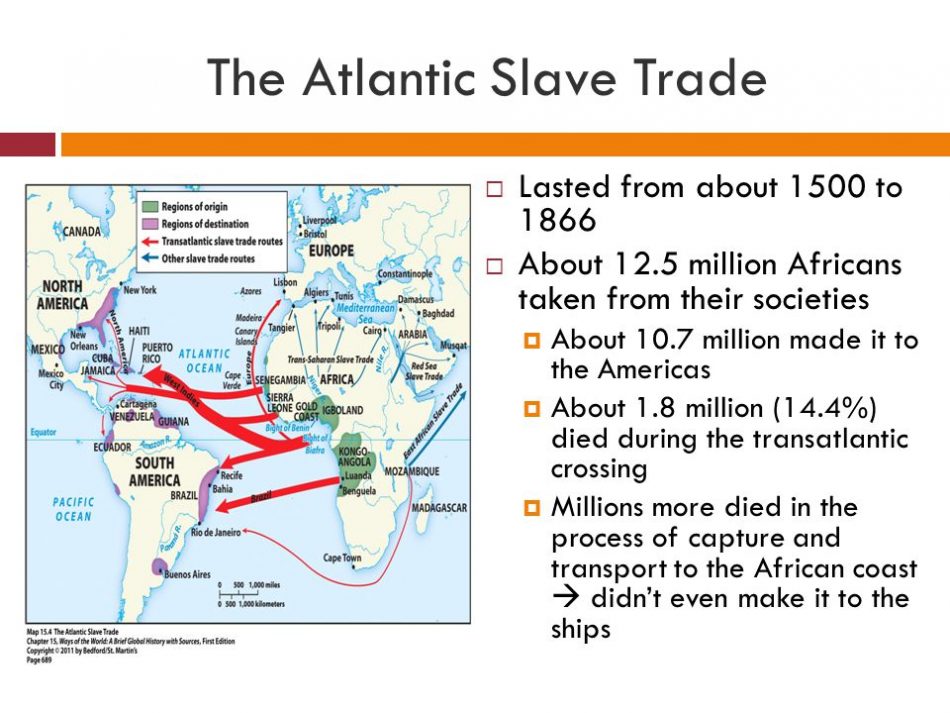
The buying and selling of slaves, especially of African people who were taken to North and South America from the 16th to the 19th century
Cambridge Dictionary
Page Description
Discover the history and impact of the slave trade,
from ancient practices to the transatlantic trade,
and its lasting effects on society.

The last known slave ship | 60 Minutes Archive
The Atlantic slave trade: What too few textbooks told you – Anthony Hazard
22 dec 2014
Slavery has occurred in many forms throughout the world, but the Atlantic slave trade — which forcibly brought more than 10 million Africans to the Americas — stands out for both its global scale and its lasting legacy. Anthony Hazard discusses the historical, economic and personal impact of this massive historical injustice.
Lesson by Anthony Hazard, animation by NEIGHBOR.
The Catholic Church’s Role in the Slave Trade: An Uncomfortable History
Back to menu IMPORTANT CONTENT Listening recommended
In première gegaan op 6 apr 2023 #documentaries #history #secrets
Welcome to today’s video on the role of Christianity in the slave trade, with a special focus on the Catholic Church. Sometimes it’s important to dive into the uncomfortable and difficult parts of history, even if it makes us squirm a little. And boy, does this topic have some uncomfortable parts.
We all know that slavery is one of the darkest chapters in human history, but what many people don’t realize is the significant role that religion played in justifying and perpetuating the practice.
And when it comes to Christianity and the slave trade, the Catholic Church was right in the thick of it. From Pope Nicholas V’s 1452 papal bull that authorized the Portuguese to enslave “Saracens, pagans, and other enemies of Christ,” to the Jesuit priests who owned slaves themselves, there’s a lot to unpack here.
But fear not, my dear viewers! We’ll take a look at the history, theology, and the human impact of Christianity’s involvement in the slave trade, all while keeping it light and (hopefully) entertaining. So sit back, grab your popcorn, and get ready to learn about a side of Christianity that might make you cringe a little. It’s going to be a wild ride!
The slave trade involved the transportation and sale of African people as slaves to the Americas and other parts of the world from the 16th to the 19th century. It was a brutal and dehumanizing practice that involved capturing and enslaving people against their will, separating them from their families and loved ones, and forcing them to work under inhumane conditions.
The origins of the slave trade can be traced back to the European exploration and colonization of Africa in the 15th century. Europeans wanted to establish colonies in the Americas, and they needed a cheap labor source to work on their plantations and mines. They turned to Africa, where they found a ready supply of potential slaves.
Africans were captured by slave traders, who would raid villages and take people by force. They were then transported across the Atlantic Ocean in brutal conditions, packed tightly into the holds of slave ships with little food or water.
Many died on the journey, and those who survived were often sick and weak by the time they reached their destination.
Once they arrived in the Americas, slaves were sold at auctions to the highest bidder. They were forced to work on plantations, mines, and in households, and were treated as property rather than human beings. They had no rights and were subject to brutal punishment if they disobeyed their masters.
The slave trade had a devastating impact on Africa, as it disrupted traditional societies and economies. Many African communities were weakened by the loss of their people, and some were destroyed entirely.
The Catholic Church was heavily involved in the slave trade, as it was seen as a way to spread Christianity to Africa and the Americas. However, the Church’s involvement was controversial, as many Catholics opposed slavery and argued that it went against Christian values.
Secret Journal is a channel for documentaries about ancient religious secrets, ancient scrolls revealing forbidden secrets and untold truths. Our mission is to reveal hidden secrets of humanity and the forbidden knowledge of our reality. Our videos will teach people the secrets of our world and the knowledge from ancient civilizations about our true nature.
Like Secret Origins and Origins Explained we make videos about secrets, documentary, documentaries, discoveries, history, reality discovery and vatican secrets and forbidden secrets.

Slave trade = did not help Africa economically because: African merchants and elites who sold the slaves kept the money for themselves and did not invest in their African societies. No technological breakthroughs in agriculture or industry to help increase the wealth of African societies. Proclamation of the New King of. Dahomey in Africa. The rich get richer, and the poor get poorer.

Lasted from about 1500 to About 12.5 million Africans taken from their societies. About 10.7 million made it to the Americas. About 1.8 million (14.4%) died during the transatlantic crossing. Millions more died in the process of capture and transport to the African coast didn’t even make it to the ships.
The slave trade refers to the historical practice of buying, selling, and transporting enslaved people for forced labor. It was a brutal and inhumane system that had a profound impact on world history. Here are some key points about the slave trade:
Historical scope: The slave trade took place over several centuries, with the transatlantic slave trade being the most well-known. It lasted from the 16th to the 19th centuries and involved the forced transportation of millions of African people to the Americas, where they were enslaved on plantations and in other industries.
Scale and magnitude: The slave trade was a massive operation, involving European slave traders, African slave sellers, and indigenous peoples who were complicit in the capture and sale of enslaved individuals. It is estimated that between 10 and 12 million Africans were forcibly transported to the Americas as slaves, with millions more dying in the process or being subjected to horrific conditions during the voyage known as the Middle Passage.
Economic motivations: The slave trade was driven by economic motives, as slave labor was used to exploit the vast natural resources of the Americas, such as sugar, tobacco, cotton, and other cash crops. European powers and their colonies benefited economically from the exploitation of enslaved labor, which contributed to the growth of their economies and the development of capitalism.
Human suffering: Enslaved people experienced unimaginable suffering, including brutal treatment, harsh living conditions, forced labor, physical and sexual abuse, and separation from their families and communities. The slave trade resulted in the loss of culture, language, and identity for millions of Africans, as well as the intergenerational trauma that continues to impact African diaspora communities today.
Resistance and abolition: Enslaved people and abolitionists fought against the slave trade and slavery through various means, including uprisings, revolts, rebellions, and organized resistance. Abolitionist movements gained traction in the late 18th and early 19th centuries, leading to the eventual abolition of the transatlantic slave trade by several European countries, and later the abolition of slavery itself in many parts of the Americas.
Legacy and impact: The legacy of the slave trade is still felt today, as it has had a profound and lasting impact on global politics, economics, culture, and social structures. It has shaped the racial dynamics, demographics, and inequalities that exist in many countries, and continues to be an important part of the ongoing conversations about social justice, reparations, and systemic racism.
It’s important to note that the slave trade was a horrific violation of human rights and remains one of the darkest chapters in human history. Understanding its key points and acknowledging its impact is crucial for comprehending the complex legacy it has left behind and working towards a more just and equitable future.
The Transatlantic Slave Trade: Crash Course Black American History #1
Back to menu IMPORTANT CONTENT
7 mei 2021 Crash Course Black American History
Today we’re learning about the Transatlantic Slave Trade, which brought millions of captive Africans to the Americas between the 16th and 19th centuries, with the largest number of people trafficked between 1700 and 1808. We’ll look at the ships and crews that brought enslaved people across the ocean via what was known as the Middle Passage and explore the horrific conditions that these captives endured.
Slavery in the American Colonies: Crash Course Black American History #2
Slavery – Summary on a Map
Back to menu IMPORTANT CONTENT
Slavery and Suffering – History Of Africa with Zeinab Badawi [Episode 16]
The Atlantic Slave Trade
The Atlantic Slave Trade: What Schools Never Told You
Back to menu IMPORTANT CONTENT Listening recommended Must
2 jan 2023 #blackhistory #history
The history of humanity is filled with oppression, dominance, war, and slavery. Since the beginning of time, people in different parts of the world have forced their fellow humans into slavery.
The tale of the Atlantic Slave Trade is the history of millions of Africans who were forced out of their communities by European slave traders and shipped across the Atlantic in conditions of great cruelty.
Full Video: The Transatlantic Slave Trade (Story of Ghana’s Slave Castles) | Jamii Yangu
10 Things You Didn’t Know About The Trans – Atlantic Slave Trade
13 nov 2020
10 Things You Didn’t Know About the Trans-Atlantic slave Trade
Hello Displorers, welcome to another informative video presented to you by Displore. In this video, we shall take you back centuries to a dark time in history to bring out 10 things you probably didn’t know about the trans-Atlantic slave trade. The Atlantic slave trade involved the transportation by slave traders of enslaved African people mainly to the Americas. The slave trade regularly used the triangular trade route and its Middle Passage, and supposedly existed from the 16th to the 19th centuries. The vast majority of those who were enslaved and transported in the transatlantic slave trade were people from Central and West Africa sold by other West Africans, or by half-European “merchant princes”while a small number were captured directly by the slave traders in coastal raids and brought to the Americas. Except for the Portuguese, European slave traders generally did not participate in the raids because life expectancy for Europeans in sub-Saharan Africa was less than one year during the period of the slave trade because of malaria. Ship owners regarded the slaves as cargo to be transported to the Americas as quickly and cheaply as possible to be sold as labour on several plantations as well as domestic servants. The first Africans kidnapped to the English colonies were classified as indentured servants, with a similar legal standing as contract-based workers coming from Britain and Ireland. However, by the middle of the 17th century, slavery had hardened as a racial caste, with African slaves and their future offspring being legally the property of their owners. In the early 21st century, several governments issued apologies for the transatlantic slave trade.
If you are new here, welcome, be sure to subscribe and turn on notifications so you don’t miss any of our videos.
Despite the lots of information out there, there are several things about this dark time which many of us may or may not still know about. We were able to narrow these into 10 things you probably didn’t know about the trans-Atlantic slave trade.
1. The Trans-Atlantic Slave Trade Was Not Only a Triangular Trade
The ‘triangular trade’ wasn’t always triangular as it is mostly asserted because it also took a bilateral form. We commonly think of the Atlantic slave trade as a three-leg affair where slavers sailed from European ports carrying manufactured goods, traded those goods for captives on the African coast, then sailed to the New World, sold their prisoners, and returned to Europe, completing the triangle. But much of the trade to Brazil, however, was bilateral where slavers left Rio de Janeiro, headed to Angola, and came straight back to Brazil. What’s more, there were many other countries and groups involved in the dark trade who did not necessarily take the triangular route.
2. It started Long Before the Date Believed
The Spanish merchant Juan de Córdoba is believed to have first transported captured Africans to the Americas in 1502. The first slave voyage direct from Africa to the Americas is believed to have sailed in 1526 but even before then, Africans were brought over as slaves directly from Europe, and native inhabitants of America were enslaved by European explorers. The Portuguese began trafficking African captives in the 1440s long before the Wars of the Roses hadbegun in England. But it wasn’t initially a transatlantic trade as in the early days, enslaved Africans were brought to Portugal or to Atlantic islands like Madeira to work in agriculture.This indicates that the slave trade started long before the recorded time.
3. Th Number of Africans Traded is Much Higher Than Projected by Historians
Because of inadequate records, the number of people taken from Africa through enslavement remains unknown. Based on the shipping records historians estimate that between 9 million and 12million people were taken out of Africa by European slave traders and delivered alive on the other side of the Atlantic. An untold number, however, died resisting capture in the “slave raids,” died during the forced march to the coastal regions, died in slave forts while awaiting transport, and died en route as they travelled across the ocean. The lowest number for the total loss of life
1 The Atlantic slave trade: What too few textbooks told you – Anthony Hazard
22 dec. 2014
2 The Transatlantic Slave Trade : History Documentary on the Middle Passage (Full Documentary)
19 mei 2015
The Transatlantic Slave Trade : History Documentary on the Middle Passage (Full Documentary).
This Documentary is very good and as educational as it is fun. It’s part of a series of exciting and informative documentaries. This Youtube channel is for learning and educational purposes. Learning and Education are fundamental and important in today’s society and becoming increasingly more accessible and convenient online. The availability of important information which is also entertaining helps everyone grow mentally and emotionally as people both individually and as a whole. Documentaries are the resource of choice of the information and internet generations of students around the world. The documentary here along with the other documentaries on this channel relate to important times and people in history, historic places, archaeology, society, world culture, science, conspiracy theories, and education. The topics covered in these video documentaries vary and cover about everything you could possibly want to know including ancient history, Maya, Rome, Greece, The New World, Egypt, World wars, combat, battles, military and combat technology, current affairs and events, important news, education, biographies, famous people and celerities, politicians, news and current events, Illuminati, Area 51, crime, mafia, serial killers, paranormal, supernatural, cults, government cover-ups, the law and legal matters, corruption, martial arts, sports figures, space, aliens, ufos, conspiracy theories, Annunaki, Nibiru, Nephilim, satanic rituals, religion, christianty, judaism, islam, strange phenomenon, origins of Mankind, Neanderthal, Cro Magnon, Inca, Aztec, Persia, Maya, Indus, Mesopotamia, monsters, mobsters, time travel, planet earth, the Sun, Missions to Mars, The planets, the solar system, the universe, modern physics, String Theory, the Big Bang Theory, Quantum Mechanics, television, archaeology, science, technology, nature, plants, animals, endangered species, wildlife, animal abuse, environmental concerns and issues, global warming, natural disasters, racism, sexism, gay and lesbian issues, and many other educational and controversial topics. Please enjoy and Learn Responsibly
3 Great Britain And The Slave Trade | Britain’s Slave Trade | Timeline
Back to menu IMPORTANT CONTENT
5 jun. 2017
5 How Liverpool Became The Greatest Slaving Port In Human History | Britain’s Slave Trade | Timeline
12 jun. 2017
6 The U.K. Scandal That Betrayed Its Own
21 mei 2021
Slavery is adhorrant and it should not have happened
7 How Britain Glossed Over Their Role In Slavery | Britain’s Slave Trade | Timeline
19 jun. 2017
IMPORTANT CONTENT
8 Britain And The Global Shame Of The Slave Trade | Slavery Documentary | Timeline
28 mei 2019
9 Slavery, Ships and Sickness – Professor Stuart Anderson
3 nov. 2011
But the trade also employed other vessels, from in-shore boats supplying the slavers, to the Navy vessels that protected them. Sickness and disease were constant companions to both slaves and crew. Mortality amongst both was high, from disease, mistreatment, accident and suicide.
Dr Stuart Anderson explores the relationship between ships, slavery and sickness, and considers the measures eventually taken to improve health at sea.
The transcript and downloadable versions of the lecture are available from the Gresham College website: http://www.gresham.ac.uk/lectures-and…
Gresham College has been giving free public lectures since 1597. This tradition continues today with all of our five or so public lectures a week being made available for free download from our website. http://www.gresham.ac.uk
10 The History of the Dutch Slave Trade 1600- 1863
11 The Passage
3 jun. 2013
12 The Atlantic Slave Trade: What Schools Never Told You
2 jan 2023 Black History
The history of humanity is filled with oppression, dominance, war, and slavery. Since the beginning of time, people in different parts of the world have forced their fellow humans into slavery.
The tale of the Atlantic Slave Trade is the history of millions of Africans who were forced out of their communities by European slave traders and shipped across the Atlantic in conditions of great cruelty
13 History of Arab Slave Trade
27 okt. 2019
14 Glasgow University is first to pay slave-trade reparations
23 aug. 2019
Slavery and Suffering – History Of Africa with Zeinab Badawi [Episode 16]
15 Why Did Britain Abolish Slavery in 1833? (Pt 1)Why Did Britain Abolish Slavery in 1833? (Pt 1)
19 jan. 2022
16 Why Did Britain Abolish Slavery in 1833? (Pt 2)
4 mei 2022
17 A Frank Look At Britain’s Role In The Slave Trade | Britain’s Slave Trade | Timeline
5 jun 2017
Gold, Silver & Slaves looks at how the business of slavery was a case of slave-trading by complicit Africans, fuelled by the greed of African kings.
This is the untold story of the greatest slaving nation in history. Up till now, Britain’s place in the history of slavery has been as the country that abolished the international slave trade.
Britain’s Slave Trade reveals the shameful truth behind this liberal facade, showing how the economic, social and cultural life of Britain would have been unrecognisable without slavery. Britain’s Slave Trade explains how a middling European power transformed itself into the ruler of the waves, tracing the impact this had on the British way of life and taking in the Industrial Revolution, the beginnings of Empire and the birth of modern racism along the way. It also unearths startling evidence showing how many families that think of themselves as ‘pure’ English stock are in fact descended from slave ancestors.
18 History of the Transatlantic Slave Trade
19 – 10 Common Slavery Myths
4 mei 2017
Comments are disabled because of the sheer amount of bigotry. This channel does not allow such behavior. There’s a comments response video, but spreading hate there or anywhere on this channel will results in a ban.
There are a lot of misconceptions surrounding the institution of slavery, especially here in the United States. These myths often serve pernicious political purposes that can be highly detrimental to a proper conception of history. So here are 10 of those myths debunked in no particular order.
For general reference and mistakes:
-I’m tired of all the racism in the comments, so they are now disabled – if you have a comment, here is a comment response video. Watch that before commenting (because you’re probably just another racist, and here’s why):
• Comments on “10 C…
1 – one example of white slavery I could have mentioned were the Amerindian slavers of Tans-Mississippi West, who would raid Spanish/Mexican colonies and visa/versa – but that is way too complicated for this myth.
2 – 3:20 – my bad, 1922 was the fall of the Ottoman Empire, 1918 was the end of WWI
5 – 7:10 – “any power not expressed” (the not is kind of difficult to hear)
7 – 8:30 – typo, Marx was born in 1818 not 1918, LOL
20 Understanding the Impact of the Trans-Atlantic Slave Trade on Africans | Africa |The Alalibo Academy
Discusses the key economic reasons Africa is attractive to the West (USA and Europe) and China.
21 The Shocking Truth About Nigeria’s Slave Trade History!
22 Bananasplit – Meisje kraakt de kluis – Dat kan niet, dat kán niet! Het kan wel…..
30 aug. 2015
xplore2012
Eindelijk……naar deze hilarische verborgen cameragrap van Bananasplit heb ik zo lang gezocht! En dan vandaag, zomaar in de uitzending van Bananasplit op Best24.
Ff op een knullige manier vastgelegd, maar mag de pret niet drukken!
BANANASPLIT – KRAAK DE CODE EN OPEN DE KLUIS
Meisje doet een poging om op de beursstand van ‘Remmers Kluizen’ de code van de brandkast te kraken om zo 10000 gulden te winnen.
De eigenaar ziet glimlachend toe hoe een meisje haar best doet om de code van de kluis te kraken.
Het lachen vergaat hem echter snel als ze na een paar minuten de kluisdeur écht opendraait en euforisch de enveloppe met 10000 gulden aan haar moeder laat zien.
Zelden iemand zo onthutst zien reageren: “Dit kán niet! Dit kán niet…….Het is absoluut onmogelijk.
Er zijn 3 miljoen combinaties te maken met deze kluis……dit kán dus niet!………Tja…… Het kan dus wel…..”‘
En toch kan het niet 😉
AAron Thom
4 jaar geleden